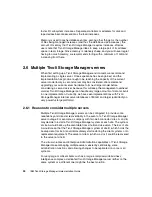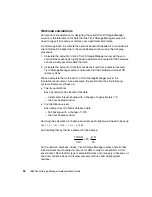
46
IBM Tivoli Storage Manager Implementation Guide
migration to the next storage pool can execute concurrently; however,
performance will degrade.
We recommend using a primary disk storage pool of at least the recommended
size to reduce interference from migration while backup is running.
2.8.9 Disk storage pool size
To estimate a primary storage pool size if running backup cycles only, do the
following:
1. Using Table 2-1 on page 18, multiply the GB changed per backup by (1 - the
Data compression rate) to give the total bytes transferred for each client.
2. Sum the total bytes transferred for all clients to give the total bytes transferred
per backup cycle.
3. Add 15% to total bytes transferred per backup cycle to give the storage pool
size. This allows for variability in the size and number of files per backup.
For example, using the sample figures in Table 2-1 on page 18, the GB changed
per backup are 6 * 20 (120 GB) and 4 * x 100 (400 GB), while the data
compression figures are 0.5 and 0.66, respectively.
1. Multiplying 120 by (1 - 0.5) gives 60, and multiplying 400 by (1 - 0.66) gives
136.
2. Summing 60 and 136 gives 196 GB.
3. Adding 15% gives a storage pool size of 225.4 GB. We will round to 226 GB.
2.8.10 Archive disk sizing
In most environments, archive disk sizing is less critical than for backup. This is
because backup operations tend to run much more frequently (usually nightly)
and to a stricter time frame. Archives may run less frequently, and on weekends
when the overall workload is lighter. Since in these circumstances the impact of
running concurrent archive and storage pool migration might not be so critical, it
is not normally necessary to use the full archive size in calculating storage pool
requirements. Another factor to be considered for sites that are doing frequent
archiving of large amounts of data, where the storage pool and processing
impact are great, is the possibility of substituting backup set operations for
archive. The advantage of this is that generating a backup set requires the Tivoli
Storage Manager server only—the client is not involved in any way since the
backup set is created using data that has already been sent to the server in
normal backup operations.
Summary of Contents for E16RMLL-I - Tivoli Storage Manager
Page 2: ......
Page 23: ...Figures xxi 22 6 AIX lab environment 708...
Page 24: ...xxii IBM Tivoli Storage Manager Implementation Guide...
Page 32: ...2 IBM Tivoli Storage Manager Implementation Guide...
Page 44: ...14 IBM Tivoli Storage Manager Implementation Guide...
Page 94: ...64 IBM Tivoli Storage Manager Implementation Guide...
Page 96: ...66 IBM Tivoli Storage Manager Implementation Guide...
Page 126: ...96 IBM Tivoli Storage Manager Implementation Guide...
Page 298: ...268 IBM Tivoli Storage Manager Implementation Guide...
Page 354: ...324 IBM Tivoli Storage Manager Implementation Guide...
Page 356: ...326 IBM Tivoli Storage Manager Implementation Guide...
Page 423: ...Chapter 12 Scheduling 393 Week of Month Expire Never tsm quit...
Page 424: ...394 IBM Tivoli Storage Manager Implementation Guide...
Page 510: ...480 IBM Tivoli Storage Manager Implementation Guide...
Page 552: ...522 IBM Tivoli Storage Manager Implementation Guide...
Page 554: ...524 IBM Tivoli Storage Manager Implementation Guide...
Page 594: ...564 IBM Tivoli Storage Manager Implementation Guide...
Page 612: ...582 IBM Tivoli Storage Manager Implementation Guide...
Page 618: ...588 IBM Tivoli Storage Manager Implementation Guide...
Page 720: ...690 IBM Tivoli Storage Manager Implementation Guide...
Page 752: ...722 IBM Tivoli Storage Manager Implementation Guide...
Page 758: ...728 IBM Tivoli Storage Manager Implementation Guide...
Page 780: ...750 IBM Tivoli Storage Manager Implementation Guide...
Page 802: ...772 IBM Tivoli Storage Manager Implementation Guide...
Page 823: ...Index 793 Z z OS tape management 58 zOS 200...
Page 824: ...794 IBM Tivoli Storage Manager Implementation Guide...
Page 825: ...IBM Tivoli Storage Manager Implementation Guide...
Page 826: ......
Page 827: ......
















































